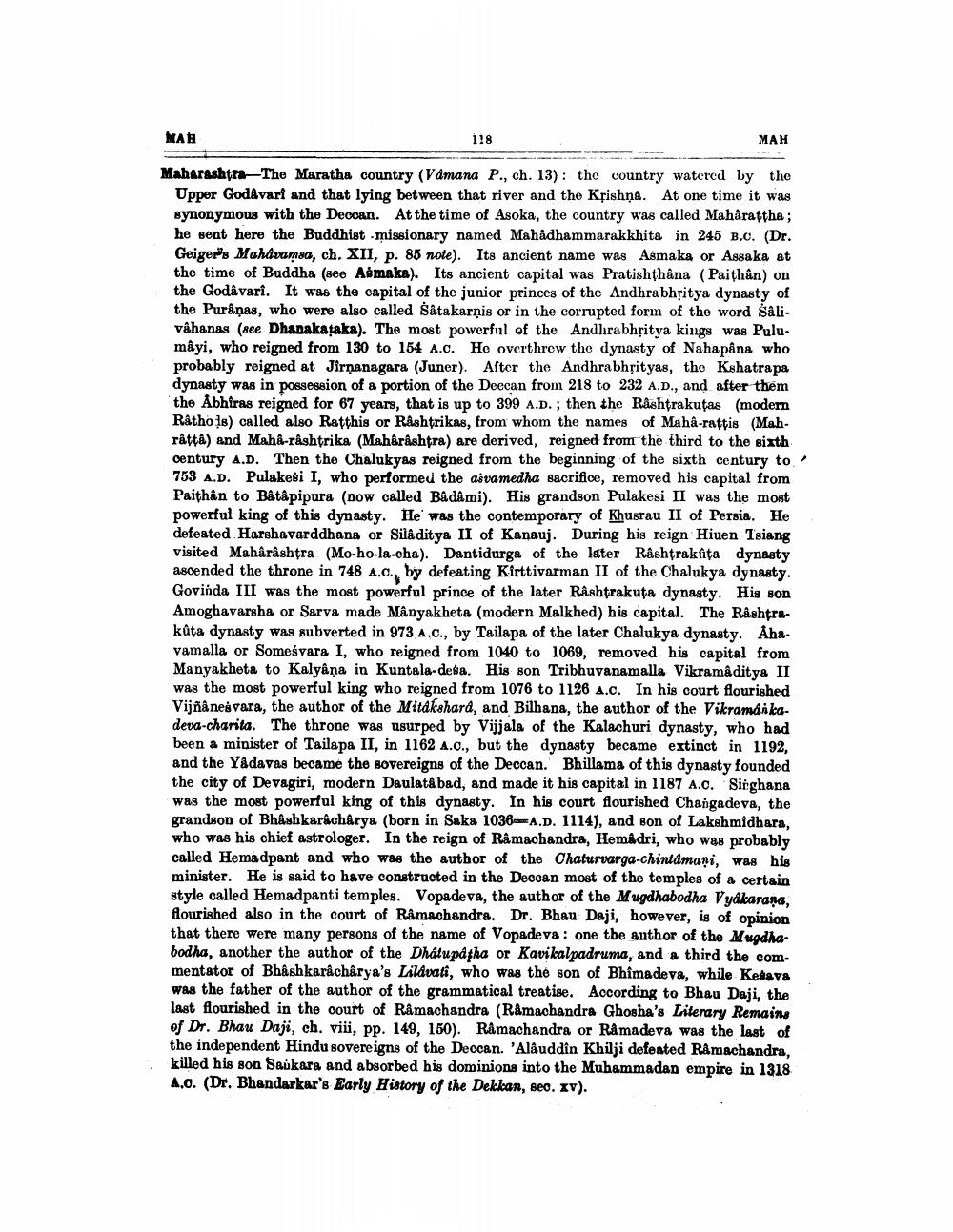________________
MAH
118
MAH
Maharashtra The Maratha country (Vamana P., ch. 13): the country watered by the Upper Godavari and that lying between that river and the Krishna. At one time it was synonymous with the Deccan. At the time of Asoka, the country was called Mahârattha; he sent here the Buddhist missionary named Mahâdhammarakkhita in 245 B.C. (Dr. Geiger's Mahavamsa, ch. XII, p. 85 note). Its ancient name was Asmaka or Assaka at the time of Buddha (see Asmaka). Its ancient capital was Pratishthâna (Paithân) on the Godâvari. It was the capital of the junior princes of the Andhrabhṛitya dynasty of the Purâņas, who were also called Satakarnis or in the corrupted form of the word Sâlivâhanas (see Dhanakataka). The most powerful of the Andhrabhritya kings was Pulu. mâyi, who reigned from 130 to 154 A.C. He overthrew the dynasty of Nahapâna who probably reigned at Jirnanagara (Juner). After the Andhrabhṛityas, the Kshatrapa dynasty was in possession of a portion of the Deccan from 218 to 232 A.D., and after them the Abhiras reigned for 67 years, that is up to 399 A.D.; then the Rashtrakutas (modern Râthols) called also Ratthis or Râshtrikas, from whom the names of Mahâ-rattis (Mahrâţţâ) and Mahâ-râshtrika (Mahârâshtra) are derived, reigned from the third to the sixth century A.D. Then the Chalukyas reigned from the beginning of the sixth century to 753 A.D. Pulakesi I, who performed the asvamedha sacrifice, removed his capital from Paithan to Bâtâpipura (now called Bâdâmi). His grandson Pulakesi II was the most powerful king of this dynasty. He was the contemporary of Khusrau II of Persia. He defeated Harshavarddhana or Silâditya II of Kanauj. During his reign Hiuen Tsiang visited Mahârâshtra (Mo-ho-la-cha). Dantidurga of the later Rashtrakuta dynasty ascended the throne in 748 A.C., by defeating Kirttivarman II of the Chalukya dynasty. Govinda III was the most powerful prince of the later Râshtrakuta dynasty. His son Amoghavarsha or Sarva made Mânyakheta (modern Malkhed) his capital. The Râshtrakûta dynasty was subverted in 973 A.C., by Tailapa of the later Chalukya dynasty. Aha. vamalla or Someśvara I, who reigned from 1040 to 1069, removed his capital from Manyakheta to Kalyâna in Kuntala-desa. His son Tribhuvanamalla Vikramaditya II was the most powerful king who reigned from 1076 to 1126 A.C. In his court flourished Vijñânesvara, the author of the Mitakshard, and Bilhana, the author of the Vikramankadeva-charita. The throne was usurped by Vijjala of the Kalachuri dynasty, who had been a minister of Tailapa II, in 1162 A.C., but the dynasty became extinct in 1192, and the Yadavas became the sovereigns of the Deccan. Bhillama of this dynasty founded the city of Devagiri, modern Daulatabad, and made it his capital in 1187 A.C. Singhana was the most powerful king of this dynasty. In his court flourished Changadeva, the grandson of Bhashkaracharya (born in Saka 1036A.D. 1114), and son of Lakshmidhara, who was his chief astrologer. In the reign of Ramachandra, Hemâdri, who was probably called Hemadpant and who was the author of the Chaturvarga-chintamani, was his minister. He is said to have constructed in the Deccan most of the temples of a certain style called Hemadpanti temples. Vopadeva, the author of the Mugdhabodha Vyakarana, flourished also in the court of Ramachandra. Dr. Bhau Daji, however, is of opinion that there were many persons of the name of Vopadeva: one the author of the Mugdhabodha, another the author of the Dhâtupátha or Kavikalpadruma, and a third the commentator of Bhâshkarâchârya's Lilavati, who was the son of Bhimadeva, while Kesava was the father of the author of the grammatical treatise. According to Bhau Daji, the last flourished in the court of Ramachandra (Ramachandra Ghosha's Literary Remains of Dr. Bhau Daji, ch. viii, pp. 149, 150). Ramachandra or Ramadeva was the last of the independent Hindu sovereigns of the Deccan. 'Alâuddin Khilji defeated Ramachandra, killed his son Saukara and absorbed his dominions into the Muhammadan empire in 1318 A.0. (Dr. Bhandarkar's Early History of the Dekkan, sec. xv).




